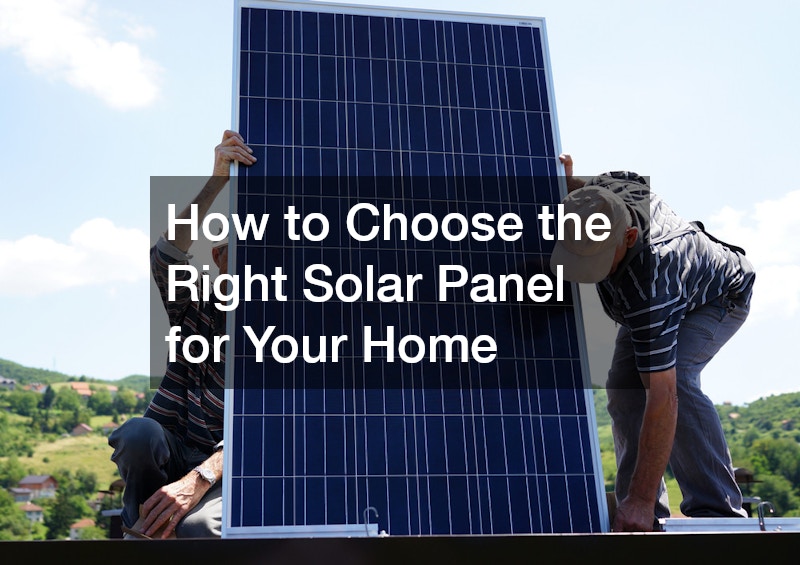As more Australians turn to renewable energy to combat rising electricity costs and reduce their environmental footprint, the demand for residential solar energy systems has surged. Choosing the right solar panel for your home is a critical decision that affects energy savings, efficiency and long-term value. With various models, materials and specifications on the market, making an informed decision requires an understanding of both technical and practical considerations.
Understanding Your Energy Needs
The first step in selecting the appropriate solar panel is to evaluate your household’s average energy consumption. Reviewing past electricity bills provides insight into daily and seasonal usage trends. This data helps in estimating the capacity of the solar system needed to offset grid dependency. It is also essential to factor in potential lifestyle changes that may affect energy use, such as a growing family, working from home or installing electric appliances like air conditioning systems or an electric vehicle charger. Matching your energy needs to the solar panel’s output capacity ensures you invest in a system that delivers optimum performance without overspending on unnecessary capacity.
Assessing Your Roof & Sunlight Exposure
Solar panels rely on consistent sunlight to generate energy efficiently. Therefore, assessing your roof’s orientation, size and shading is key. North-facing roofs in Australia typically receive the most sunlight throughout the day, making them ideal for panel placement. East- or west-facing roofs can still be viable options, though they may experience reduced efficiency. Additionally, surrounding trees, chimneys or neighbouring buildings that cast shadows on the roof can impact the solar panel’s effectiveness. A solar installer may conduct a site assessment to determine the most effective layout and to decide whether any obstructions should be removed or trimmed. The pitch of the roof also influences performance; in most cases, an angle between 15 and 30 degrees is recommended for optimal energy capture.
Comparing Solar Panel Types
There are several types of solar panels available, each with distinct advantages and drawbacks. Monocrystalline panels are known for their high efficiency and sleek appearance. These panels are ideal for homes with limited roof space as they generate more electricity per square metre than other types. Polycrystalline panels, on the other hand, are usually more affordable but slightly less efficient, making them suitable for larger roof areas where space is not a constraint. Thin-film panels offer flexibility and a lightweight profile, but they generally provide lower efficiency and may degrade faster over time. Choosing the right type of solar panel hinges on balancing cost, available space and efficiency requirements. It’s important to consider the long-term performance rather than focusing solely on upfront costs.
Evaluating Efficiency & Warranty
Efficiency ratings indicate how well a solar panel converts sunlight into usable electricity. Higher efficiency means the panel can produce more energy using less surface area, which can be especially beneficial for homes with limited roof space. Most quality panels offer efficiency rates between 15% and 22%. Another important factor to consider is the panel’s degradation rate, which measures how much the performance declines over time. Reputable manufacturers often provide performance warranties guaranteeing 80% or more of original output after 25 years. Additionally, product warranties cover manufacturing defects and typically range from 10 to 25 years. Choosing a solar panel with strong warranty terms reflects the manufacturer’s confidence in its product and offers peace of mind to the homeowner.
Considering the Inverter & Other System Components
Although the solar panel itself is the most visible component, the inverter plays a critical role in converting the direct current (DC) electricity generated by the panels into alternating current (AC) electricity used in the home. There are different types of inverters, including string inverters, microinverters and hybrid models that integrate battery storage. The choice of inverter affects system efficiency and flexibility, especially in shaded or multi-directional roof installations. Battery storage systems can also be included to maximise self-consumption and minimise reliance on the grid during peak periods or outages. When planning your system, make sure all components, including the inverter, mounting hardware and batteries (if applicable), are compatible with the chosen solar panel.
Seeking Accreditation & Installer Reputation
Installing a solar energy system is a significant investment and working with accredited professionals ensures quality and safety. In Australia, installers should be accredited by the Clean Energy Council (CEC). This certification guarantees that the installer meets industry standards and that your system is eligible for government rebates or incentives. Additionally, researching the reputation of both the installer and the solar panel manufacturer is wise. Customer reviews, case studies and testimonials can provide insights into service reliability and after-sales support. An experienced installer can also help you navigate local regulations and grid connection requirements, streamlining the entire process.
Make a Smart Solar Choice for Long-Term Benefits
Choosing the right solar panel for your home involves careful consideration of your energy needs, roof characteristics, budget and long-term goals. With the right combination of quality components, a reputable installer and appropriate system design, you can enjoy reduced electricity bills, increased home value and the satisfaction of contributing to a cleaner environment. Taking the time to evaluate these factors thoroughly ensures your investment in solar technology delivers enduring rewards for years to come.

